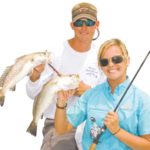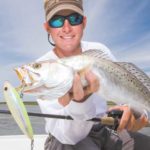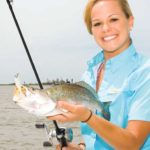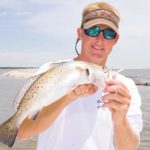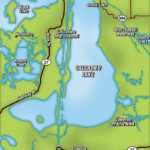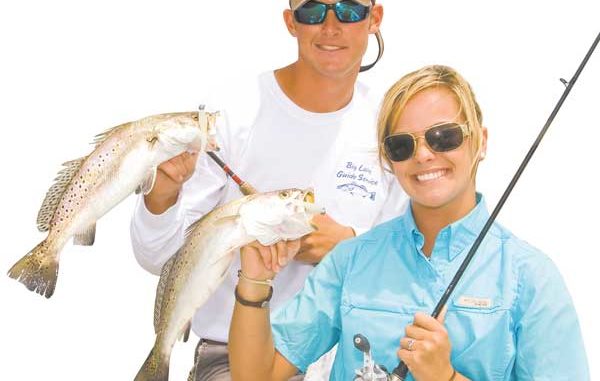
There’s one Super Highway that centralizes trout activity on Calcasieu Lake this month.
At the expense of small towns all across America, the Interstate system became a traveler’s best friend as Americans realized they could speed from one side of the country to the other without anything in their way.
Entrepreneurs soon realized that if they wanted in on the gas, snack and sleep-over action, they would have to relocate their businesses along the interstates that congregated travelers — namely the entrance and exit ramps to the long, straight sections of featureless roads.
Speckled trout aren’t much different than American travelers. They realize that the shortest distance between two points is a straight line, and at Calcasieu Lake, that straight line is the Ship Channel. And there are more trout in this channel at any given point in July than there are vacationers on the Interstate.
As the water temperature in the main part of Calcasieu Lake gets hot enough to boil its own shrimp, trout begin to move toward the deeper and cooler water in the Ship Channel.
Some, not being satisfied with what the channel offers, move on down to the Cameron Jetties, where the channel empties into the Gulf of Mexico. If the jetties aren’t good enough for them, some of those trout push on out to the nearby oilrigs to the east and west of the jetties.
Wherever the trout wind up during July, Capts. Jeff and Nick Poe know that the best way to stay on the bite this month is to relocate to points along the Ship Channel that congregate trout. Whether it’s ledges in the channel, flats just off the channel, the jetties or oilrigs, they understand that putting up big numbers of fish means moving with them.
“That’s not to say you can’t catch trout in the main lake, because you can,” Nick Poe said. “There’ll be some birds picking, and you can still drift the reefs — even get the topwater bite on some of the shallow flats, but we move to the Ship Channel because it’s the best place to quickly catch a lot of trout.”
The move to the channel doesn’t happen overnight, though. According to Nick Poe, it’s more of a gradual movement that could almost go unnoticed by a dull eye. Therefore, the best way to know when the trout have moved is to spot-check the Ship Channel beginning in late June.
While you could catch trout anywhere from 1 foot to 20 feet in the Ship Channel, Nick Poe most frequently finds the thickest concentrations along the first major drop-off in about 6 feet of water. Whether the trout move up from deep water to eat or they patrol the drop back and forth, he says fishing this drop is his No. 1 way to catch Calcasieu trout during July.
“A lot of times you’ll catch five or six fish in a row, then hit a little dry spell,” he said. “Then you’ll hit five or six more a little while later. I think a lot of these trout move back and forth on the drop, and you’ll pick up a few trout each time they move by you. I like to stay on the trolling motor until I pick up some fish, then I’ll drop anchor and work on them as long as they’ll let me.”
One consideration to keep in mind is that the trout bite in the Ship Channel is much better on a falling tide because it opens up more spots to fish, and the bite in the southern section of the channel gets really good.
On the other hand, with an incoming tide, Nick Poe recommended staying above Nine-Mile Cut, as that is where the prettiest water would be.
Nick Poe’s favorite lure for fishing the Ship Channel drop-offs is either a glow/chartreuse or avocado Norton Sand Eel. He rigs it on different size lead-head jigs based on the strength of the current in the channel. He typically goes with 1/4- and 3/8-ounce heads, but will go up to 1/2-ounce if necessary.
The most critical component to consistently catching trout along the drop-off, according to Nick Poe, is to cast upcurrent and allow the current to naturally wash the bait back toward your boat. He hops his plastic off the bottom every now and then, but he believes a natural slow-and-steady presentation is best.
“You’ve got to stay in contact with your bait when you’re fishing like this,” he said. “If you can’t feel what your bait is doing, you’re not going to catch nearly as many trout. I like to let my bait go down to the drop and just kind of swim it back while reeling in line at a pace fast enough to keep the slack out.”
Anything that keeps his bait from staying down on the bottom becomes a problem for Nick Poe. That’s why he sticks with light 10- to 12-pound-test monofilament when fishing this way. Light line is thinner than heavy line, and it more effectively cuts through the current rather than getting pushed around by it.
“I’ve also been playing around with the braided line, and I like it,” Nick Poe said. “Fifteen- or 20-pound-test braided line has the same diameter as 6- or 8-pound-test mono, and it really helps my bait stay on bottom in that current. I tie a 20-pound mono or fluorocarbon leader to it, though, because I have seen it where tying directly to the braided line keeps you from getting as many bites.”
Poe fishes much the same way when he moves to the jetties, but rather than cast upcurrent and work his bait back to him, he lets his boat drift along with the current, which is typically stronger at the jetties, and casts downcurrent in front of his boat. Otherwise, he says the plastic would wash back to his boat too quickly if he cast upcurrent.
Once you get on a few fish, you can anchor and turn it around and fish just like you do in the Ship Channel.
“The only reason I cast downcurrent when drifting is to get my bait down to where the fish are,” he said. “That’s the only thing that matters in that strong current.”
Trout on the jetties are sometimes as shallow on the rocks as the redfish are, but they can also be off the rocks swimming around over the loose rocks that have slid down toward the bottom in deeper water. A good rule of thumb is to fish as far out as you can and still feel the rocks. If you aren’t getting hung every now and then, you’re probably fishing too deep.
While the Ship Channel and Cameron Jetties hold lots of speckled trout during July, they also hold lots of anglers. That’s why Jeff Poe frequently moves offshore and fishes the nearby rigs that are up to 35 feet deep.
“Any deeper than that, and you start getting into other kinds of fish,” he said. “You can fish all the Johnson Bayou rigs to the west and the jack-up rigs straight south of the jetties. But if you’re fishing the block to the east of the jetties — what most people call the Superior Rigs — I would recommend fishing the platforms closest to the beach. The rigs in the southern part of that block get up to 40 feet deep, and that’s a little bit too deep for trout.”
Jeff Poe says water movement around the rigs is important in turning on the trout, but, for the life of him, he hasn’t been able to predict how hard the current will be running out there until he gets there. He recalls many times that he’s run all the way to the rigs only to turn around and run right back in because there was too much current.
However, he has been able to determine that the trout don’t get locked into setting up in particular locations based on the current. He’s found them upcurrent and downcurrent, so he prefers trolling around each rig to pinpoint where the trout are holding on that particular day.
“I’ve also seen that the greener the water, the deeper the trout will be,” he added. “The dirtier the water, the closer to the surface they’ll be. I generally stick with fishing the Norton Sand Eel, sparkle beetles and some of the cocahoe tails — opening night has been hot lately — out on the rigs. I let them sink to the depth of the fish, and swim them through that zone.
Many trips, he’s had to fish heavier jigheads than what he would normally fish just to get his plastic down through the hardheads, ladyfish and bluefish. These aggressive fish might crush a 3/8-ounce head before it could get down to the trout, whereas a 1/2-ounce head may get it through these schools of fish.
“I’ll also try topwaters every now and then out on the rigs,” Jeff Poe said. “I don’t just go out and start throwing them, though. I’ll pick up a topwater if the trout are hitting my jig just below the surface.”
During July at Calcasieu Lake, it’s OK to keep those main-lake spots in mind. Like a small town off Route 66 that doesn’t get as much business since the inception of the Interstate system, those spots will be nice to visit.
However, if you want to stay in the fast lane and quickly fill your cooler with fish during July, the Calcasieu Ship Channel should be your new best friend. It’s a straight shot to some fast speckled-trout action.
Contact Capts. Jeff and Nick Poe with Big Lake Guide Service at 337-598-3268. Follow the author’s blog at www.chrisginn.com.
